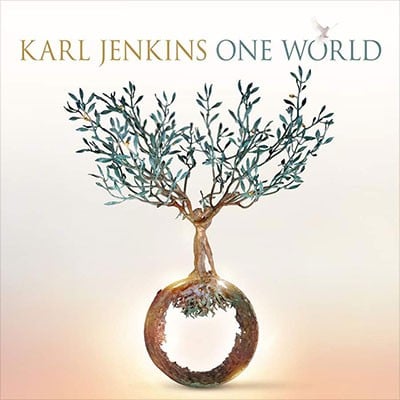One World
(2021-2022)Various
1.picc.1.corA.1.bcl.1.dbn-4.3.3.1-timp.perc(4):glsp/xyl/tgl/t.bells/mark.tree/wind.chimes(optional)/bamboo.chimes(optional)/ankle.bells/finger.cyms/shekere/caxixi/darbuca/udu.dr/djembe(optional)/riq/congas/snare.dr/SD/BD/tpl.bl/cyms/susp.cym/tam-t/tom-t/low floor tom-t/dr.kit-strings
Abbreviations (PDF)
Boosey & Hawkes
One movement from One World encapsulates what the project is all about: ‘Tikkun Olam’, Hebrew for ‘repair the world’. The work, for soloists, choir and orchestra, heralds a vision of a peaceful and egalitarian planet that treats nature and ecological issues with respect and where human rights are universal. Where truth is truth and news is never ‘fake’, where leaders do not lie, transparency is a given and all faiths live together in peace. There is neither famine nor war.
In the Beginning represents the creation of the world and is presented from two conflicting perspectives: current cosmological theory, marking the origin of the universe with a ‘big bang’; also from the perspective of the Genesis text that has been central to Abrahamic religions for centuries, just as the composer Haydn presented it in his oratorio The Creation.
Let’s Go! This text (The Tower of Babel, also from Genesis) was the explanation for the dispersal of people and the multiplicity of languages and is now viewed as an origin myth or allegorical. God was concerned that humans had blasphemed by building a tower to reach him, so he came down to earth and confused their language so that they were unable to understand one another ‘and from thence did the LORD scatter them abroad upon the face of all the earth.’ The choir speaks the narrative in a rhythmical style akin to rap. Towards the end the choir diverges, individually adopting different spoken global text replicating a multitude of people. The movement ends with a shout, ‘scattered!’ This leads us into …
Unus Mundus, where ‘one world’ is chanted and sung in various global languages, beginning with some of the earliest known. This develops the idea of ‘we are one people’, ‘one family’ and that ‘freedom will fill all things with light’, which segues into …
Ad Lucem (Towards Light), a short instrumental movement that features a solo violin with orchestra, then…
Ad Pacem (Towards Peace), a choral anthem, ‘Dona nobis pacem’ (‘give us peace’) with a chant of unus mundus closing the movement, over which ‘one world’ is heard in Morse Code, played by a solo clarinet. 3, 4 and 5, despite being designated as such, are played segue as one continuous movement. The next three movements represent a search for enlightenment and a plea to save our world.
Yet, here I am, is a spiritual search by the writer, who takes us through time and space, and many faiths, seeking ‘ultimate reality’: a deity, faith, fulfilment, happiness, nirvana etc. The text is the Song of Humankind by Kahlil Gibran (1883–1931) the Lebanese-American who also wrote The Prophet.
Tikkun Olam (Hebrew) is a plea, ‘L’taken olam bamalchut Shaddai’ – ‘to repair the world under the kingdom of God’, featuring solo violin and cello.
Savitur. The text, in Sanskrit, and thousands of years old, is a setting of the Gayatri Mantra, a sacred prayer, revered in Hindu culture. It consists of a group of words that is repeated as an aid to meditation. The basic loop of four bars is chanted twelve times. Savitur means ‘the inner sun’. The chant itself is also traditional but I have modified the melody. The piece begins quietly, then a gradual crescendo ensues which takes us to a massive climactic conclusion. There is a plethora of translations for this mantra but here is the gist: ‘Divine mother (the Sun), may your radiance enlighten all parts of our being; the physical, the cerebral and the spiritual. Please purge sin from our souls and inspire us to true enlightenment.’ In the recording the first few vocal bars are chanted by me before the chorus enters, the first time my voice has been heard on a commercial release. It was meant to be a guide vocal for the choir, but some were seemingly drawn to it (even when they did not know it was me!). So it stayed.
The mantra is followed by four movements that deal with specific issues affecting our world.
Paradise Lost? is a recitative for choir and orchestra, reflecting on our planet, global warming, nature, ecology and the pandemic.
Truth. The initial Latin text proclaims the beauty and virtue of truth (‘veritas’ in Latin), followed by English text dealing with the antithesis: abuse of human rights, mendacious politicians, dissemination of misinformation. I composed this movement ‘in a retro style of an 18th-century Italian operatic aria’, with the intention of lending a bittersweet or ironic air to the proceedings.
Hidden Faces is a reminder that slavery is not only historical but is very much with us today: human trafficking, sex trafficking, forced labour. This short prologue segues into …
Bury me in a free land, sung in a musical genre redolent of a work song. The content is more than adequately described by the libretto. The final two movements represent a time of rebirth and hope.
Sakura, Spring has Come. In Japanese culture, cherry blossom (sakura) in bloom represents a time of renewal. The complementary English text by Carol Barratt stands alone and is not a translation of the Japanese.
The Golden Age Begins Anew is taken from Chorus II, which forms the closing section of the verse drama Hellas, by the great English Romantic poet, Percy Bysshe Shelley (1792–1822). Before we hear this anthemic section, sung to the melody of (4) Ad Lucem, the phrase ‘Let us all proceed in peace’ is sung in Latin by the choir.
The closing section is in my invented Adiemus-style language, encrypted so that the text Ni ud ebi. Ebi kep umm. Mexi ubs spasz. Mexi ubs riuvi can be decoded into English.
Karl Jenkins, March 2023
"A sensational success at the Brucknerhaus... a contrapuntally woven, ingeniously composed work which Jenkins permeates with harmonic invention... a hurricane of cheers accompanied by a standing ovation."
Volksblatt

Lucy Crowe/Kathryn Rudge/Roderick Williams/
The Stay at Home Choir/World Choir for Peace/
World Orchestra for Peace/Karl Jenkins
Decca Records 4839748

